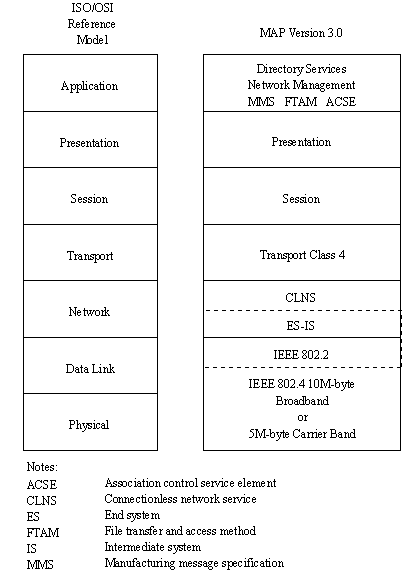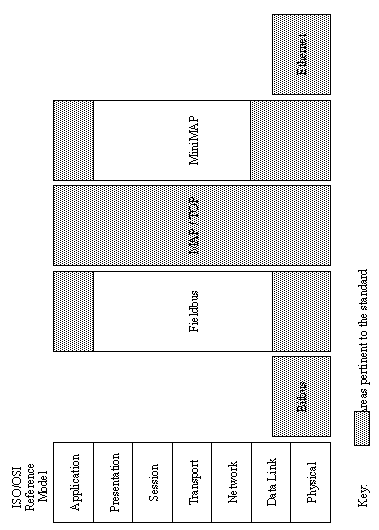allows connections between different network types (such as a connection between Broadband and Carrierband)
6.2.2 Data Link Layer (Layer 2 OSI Model),
• Real time response was required, so token passing is used.
• Token passing allows a ‘token’ to be passed between computers, whichever computer has the token is given control of the network.
• The token is continually passed to each machine on a network.
• If a token passing ring is broken, the computers will wait, and eventually each half of the broken ring will have tokens being passed.
• Extensive algorithms have been developed for control of token passing, and resolution of conflicts.
• Preferred LAN is IEEE 802.4 token-passing bus.
• Uses standard ISO network, transport, session, and presentation layers.
6.2.3 Application Layer:
FTAM (File Transfer Access Method) for file transfer
MMS (Manufacturing Message System) for content of messages bound for robotic equipment
ACSE (association Control for Service Elements) for program to program communication.
Set of protocols should make communication between heterogeneous devices, not only in moving data around, but also in communication the meaning of that data.
MAP has been delayed because of changes to the standard between 2.1 (1985) and 3.0 (1988)
A version of MAP, EPA (Enhanced Performance Architecture) has been developed, and is supported by the process control industry, and CNMA (Communication Networks for Manufacturing Applications)
CNMA has lobbied for the inclusion of Ethernet (IEE 802.3) as an alternative for the standard.
• MAP Layers Compared with the ISO/OSI Reference Model

• TOP (Technical and Office Protocols) is designed for the office environment.
• Preferred LAN is IEEE 802.3 Ethernet, But allows for Token Bus (IEEE 802.4) and Token Ring (IEEE 802.5). Fibre optical media will be added when they are defined.
• uses same ISO standards for network, transport, session and presentation layers that MAP uses
6.3.1 Application Layer:
• ACSE and FTAM are the same as MAP, MMS is not included
• (MHS) CCITT X.400 message handling service provides electronic mail transfers of all types of documents
• ISO Virtual terminal protocol to allow a terminal on any machine to log onto any other machine.
• ODA/ODIF (ISO Office Document Architecture and Office Document Interchange Format) To permit formatted documents to be transmitted independently of the package used to create them. (Text, and Raster or Line graphics)
• CGM (ISO Computer Graphics Metafile) to permit the exchange of geometrical graphics
• IGES (ANSI Initial Graphics Exchange Standard) to exchange product design information among CAD/CAM workstations.
• Suggested that the two protocols MAP for CAM, and TOP for CAD be separated at the database level.
• STEP (Standard for the Exchange of Product Data) based on PDES, is an international standard to facilitate the transfer of data in CAD/CAM.
• GOSIP (Government Open Systems Interconnection Profile) has been developed by the U.S. Government (NIST) to provide an open systems standard fro their computers. GOSIP is almost a subset of TOP 3.0
• TOP Protocol Layers Compared with the ISO/OSI Reference Model

• ISO/OSI Reference Model Compared with Factory Communication Standards

• MAP Enhanced Performance Architecture (EPA) and MiniMAP Protocol Stacks

• One proposed MAP-compliant approach to computer integration is the introduction of an FMS into the plant-wide data communications network)
• All seven MAP layers reside and run on each board set of this board-level MPA interface

• Speeds often measured in bps (bits per second) but we are more interested in the bytes per second. There is approximately an 11:1 ratio.
baseband: single frequency- only one station may transmit at any time (Ethernet, ARCnet, Token ring). These must be in discrete digital packets.
boradband: multiple frequencies allow multiple simultaneous data streams. This network can reach higher speeds by multiplexing and can have continuous and/or analog channels (ISDN, CATV,ATM)
• Networks are some mix of clients and servers.
server: will share reseaources (eg, files) with many remote computers
client: a computer that typically talks to a limited number of servers
• Token based networks rotate talk permissions between machines by passing a “token”
• ARCnet: a token passing network that is relatively immune to noise
• IBM token ring: a star topology token passing network
• FDDI: fiber based token passing rings that rotate in opposite directions